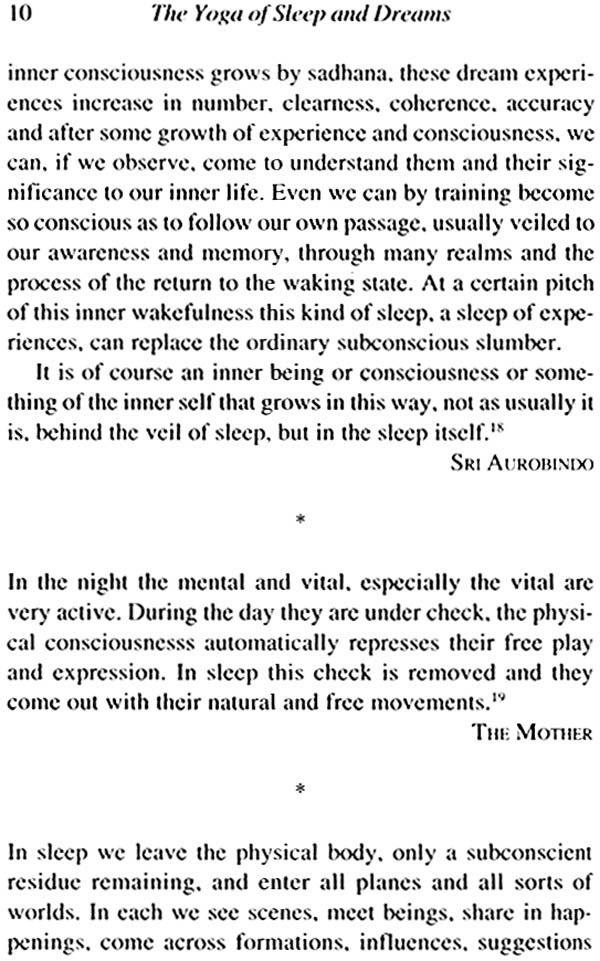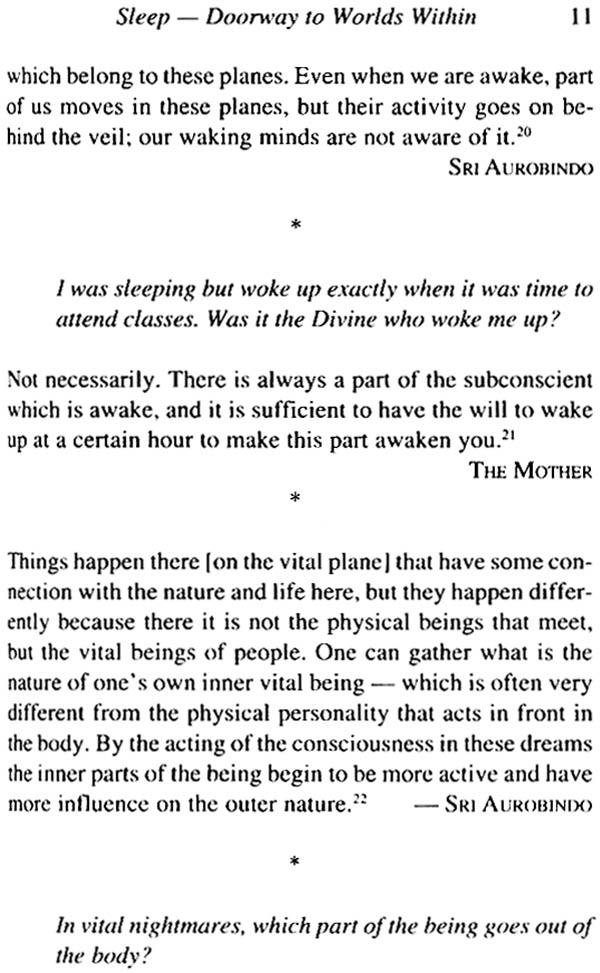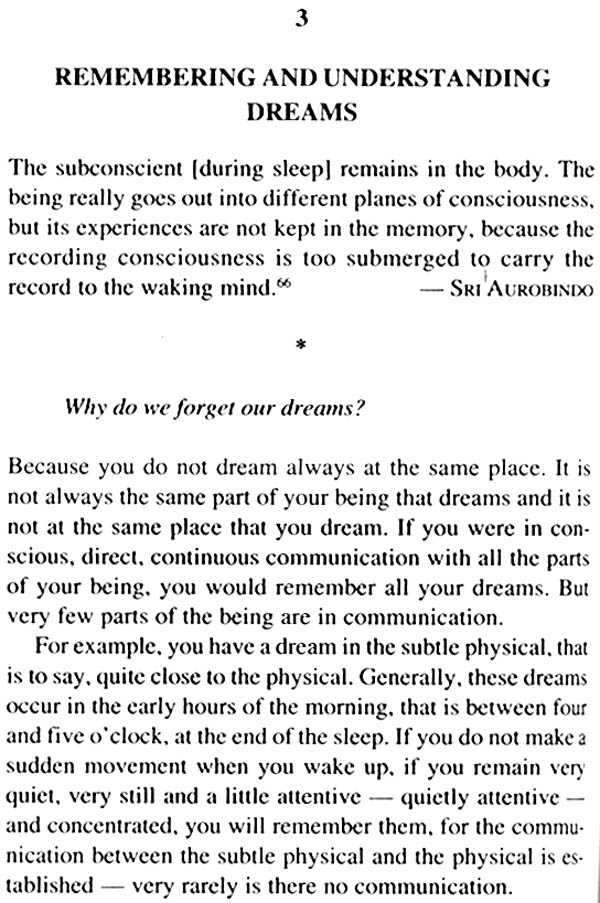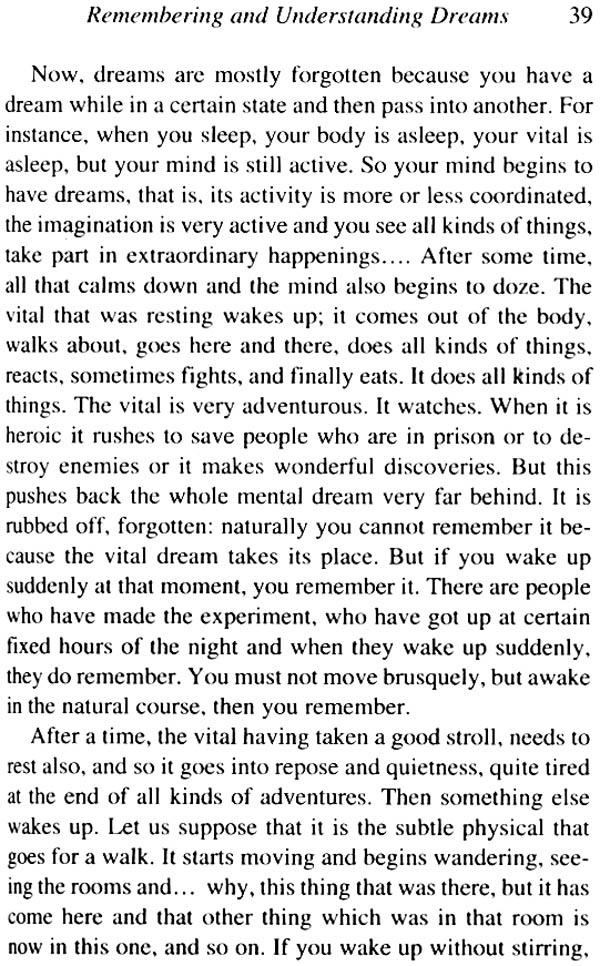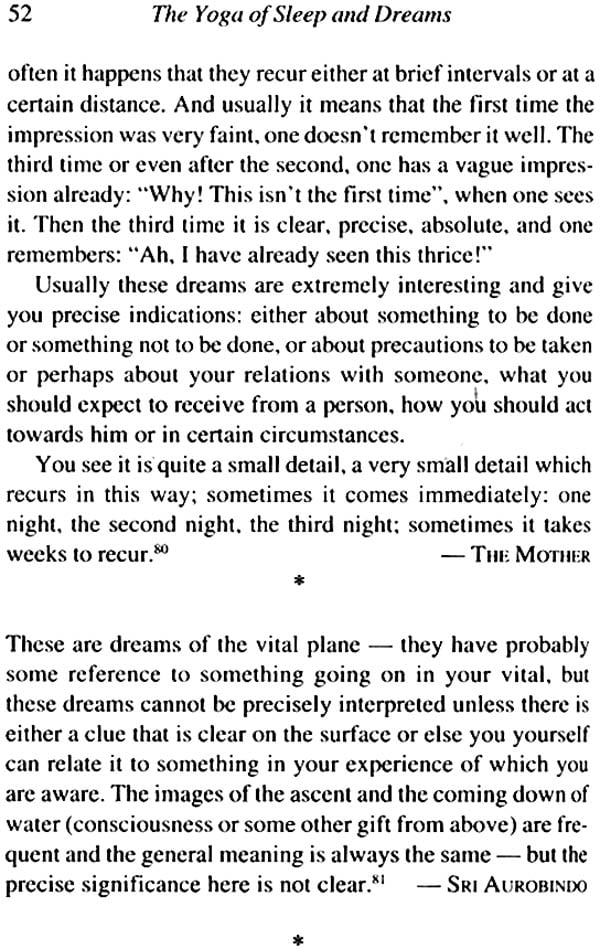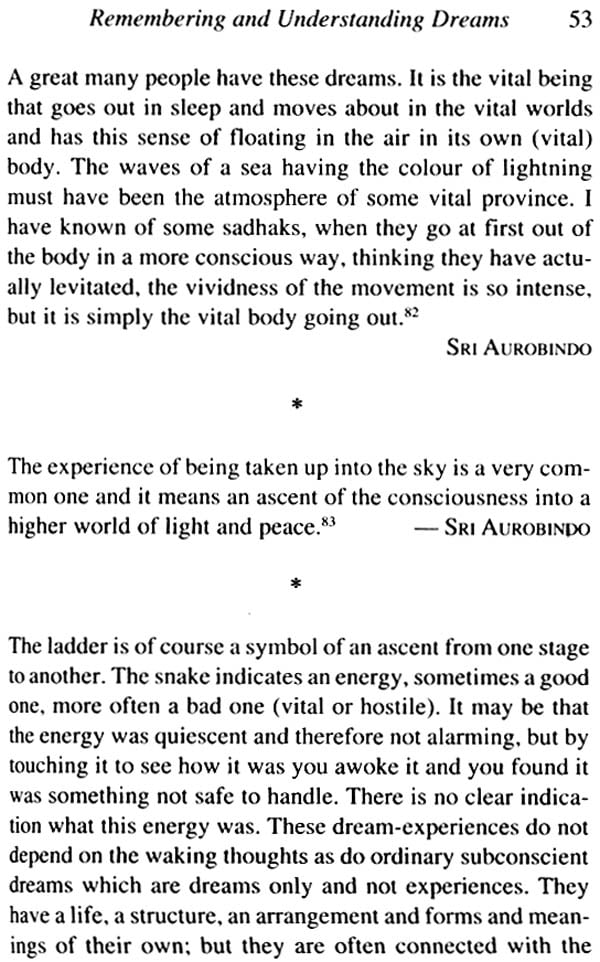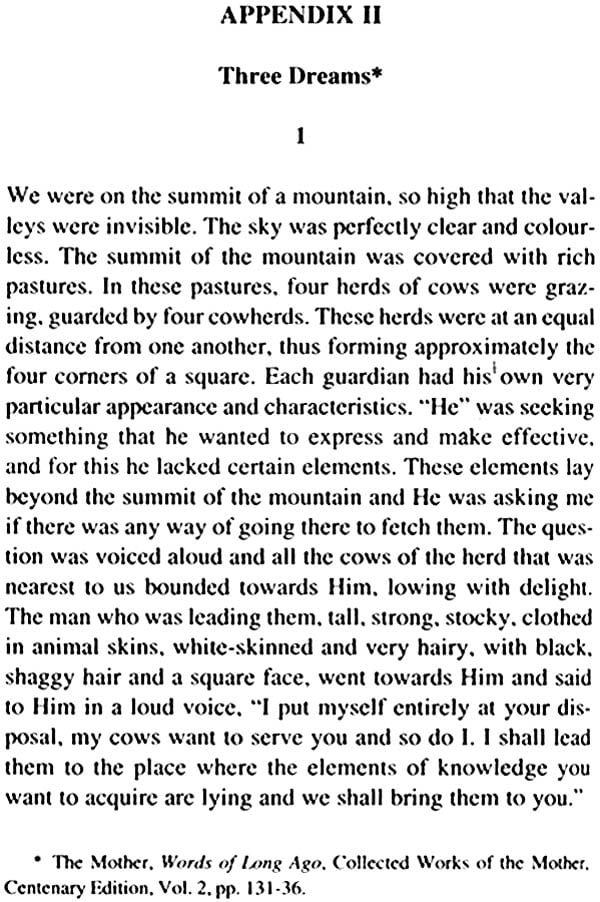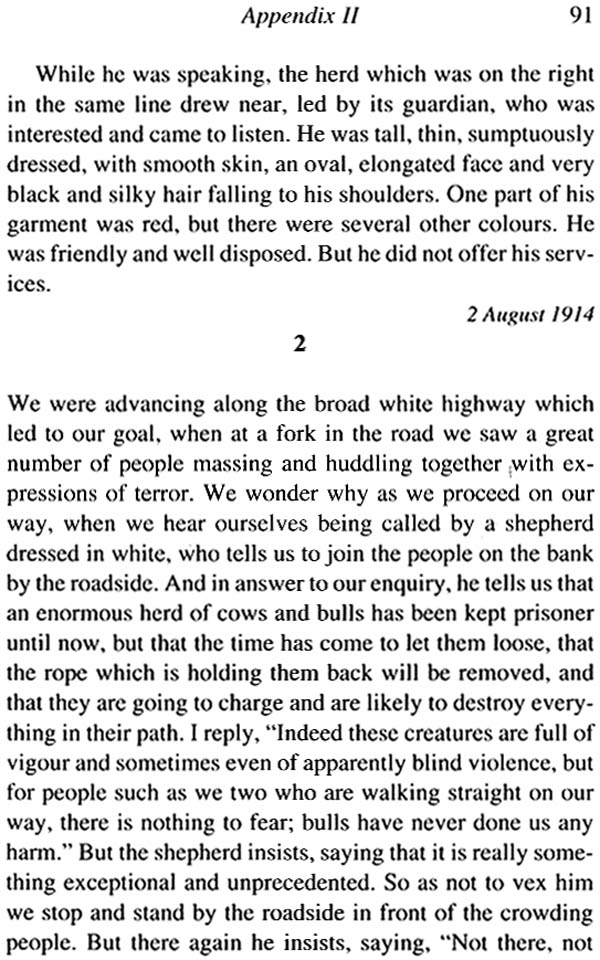
The Yoga of Sleep and Dreams: The Night-School of Sadhana
Book Specification
| Item Code: | IDI944 |
| Author: | Sri Aurobindo and the Mother |
| Publisher: | Sri Aurobindo Ashram |
| Language: | English |
| Edition: | 2012 |
| ISBN: | 9788170587507 |
| Pages: | 107 |
| Cover: | Paperback |
| Other Details | 7.2" X 4.8" |
| Weight | 70 gm |
Book Description
Back of the Book:
The right way is to transform the sleep..... and especially to learn how to become more and more conscious in sleep itself. If that is done, sleep changes into an inner mode of consciousness in which the sadhana can continue as much as in the waking state, and at the same time one is able to enter into other planes of consciousness than the physical and command an immense range of informative and utilisable experience.
- Sri Aurobindo
You can become conscious of your nights and your sleep just as you are conscious of your days. It is a matter of inner development and discipline of consciousness.
- The Mother
Preface
A rare and rich treasure among the spiritual discoveries of world-teachers down the ages lies in the largely unknown wisdom about sleep and dreams which is to be found in the teachings of Sri Aurobindo and the Mother. This book represents a distillation of these teachings.
In common parlance, dreams figuratively signify things which are unreal, for to our ordinary consciousness the world of reality is what we experience in the waking state; what we experience in the dream state is regarded by us as an unreal phantasmagoria which is usually chaotic and seemingly devoid of any real significance. Western psychology, beginning with Freud and continuing with Jung, has thrown some light on the meaning of dreams. As a result, we now understand at least to some extent the significance of dreams and what they can reveal about elements of our nature which are largely concealed to our conscious awareness. But whereas some progress has been made in understanding the meaning of dreams, the nature of dreams still eludes us. Thus, Arthur S. Reber, author of the Penguin Dictionary of Psychology, remarking that "a lot of people have wrestled" with the definition of dream, suggests that we settle for "images during sleep" as a definition. Such a whittled down definition is a frank admission of the paucity of our ascertained knowledge about the nature of dreams.
From the viewpoint of the yogic psychology of dreams presented in this book, one chief limitation of our present-day understanding of the nature of dreams lies in its lack of the distinction which yogic psychology makes between dreams and dream-experiences. Dreams, which constitute most of what we ordinarily bring back form sleep to our waking recollection, are products of what Sri Aurobindo calls the subconscient - that part of our constitution which lies between consciousness and total in conscience. Distinguished from these ordinary dreams are dream-experiences which are recordings of transcripts if actual events in supraphysical or inner (subliminal) realms of our existence which are as real and concrete as the physical world if not more so, and into which sleep gives us an entry. "In each we see senses, meet beings, share in happenings, come across formations, influences, suggestions which belong to these planes. Even when we are awake, part of us moves in these planes, but the activity goes on behind the veil; our waking minds are not aware of it." A dream-experience is a direct or symbolic record of what happens to us in these realms. Unlike the ordinary dreams which come from the subconscient and which are chaotic, confused and tiring, dream-experiences, especially those in the subliminal realms, are clear and coherent (though often mixed and distorted by the subconscient), and produce a deep feeling of insight or elevation. The three early dreams of the Mother in Appendix II are examples of such inner experiences during the dream state. The aim of the yoga of sleep and dreams in the beginning is to replace what is commonly a slumber of subconscious dreams with a sleep of inner experiences. Sleep then becomes as much a part of sadhana as the waking state. The key for being able to continue sadhana during sleep lies in becoming more and more conscious, not only during the waking hours but also during sleep. The fact that one can become conscious during sleep has been known to yogis since ancient times, but it is only during the past few decades that scientific psychology has been interested in the experience of consciousness during sleep. The interest has been aroused by the phenomenon of what are called "lucid dreams" -dreams in which one knows that one is dreaming.
Jayne Gackenbach, one of the foremost researchers of lucid dreaming, has arrived at a theory, based on studies carried out by herself and others, that lucid dreaming is only the beginning; it is only one step along a developmental continuum of consciousness during sleep, and that there are further steps of development beyond lucid dreaming. She states:
The potential far-reaching implication of consciousness in sleep are just beginning to be investigated if not appreciated. We are at the entry of a new era in our understanding of such states and their implications for full human functioning.
The psychology of sleep and dreams, founded on yogic experience, contained in the pages of this book illuminates Gackenbach's theory by placing it in larger and deeper perspective, and indicates the farthest goal of the yoga of sleep and dreams - that of transforming sleep from a state of semi-unconsciousness into a state of yogic repose in which one is as conscious during "sleep" as one is during the waking state. In order words, the highest goal envisaged is to become fully and continuously conscious throughout the day and night, capable of consciously entering the inner worlds of existence at will and acting there, if necessary, as one would of existence at will and acting there, if necessary, as one would act in the physical world. This book also contains guidance for making sleep more and more conscious, thereby progressively replacing subconscient dreams with conscious experience of the inner realms of our being.
| Preface | ix | |
| Introduction | xiii | |
| 1. | Sleep - Doorway to Worlds Within | 1 |
| 2. | Dreams and Dream-Experiences | 22 |
| 3. | Remembering and Understanding Dreams | 38 |
| 4. | Sleep, Dreams and Sadhana | 56 |
| Appendix I | On Dreams | 80 |
| Appendix II | Three Dreams | 90 |
| Glossary | 97 | |
| References | 102 | |
| Index | 106 | |
